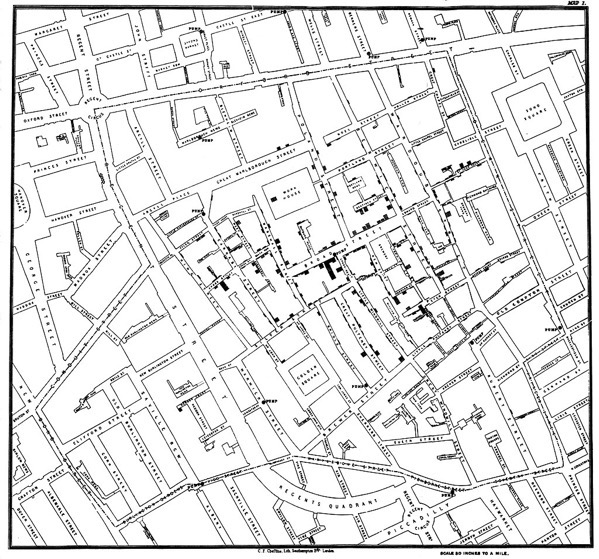As a child, John Snow showed an aptitude for mathematics and science and obtained a medical apprenticeship in 1827 at the age of 14.
In 1831, the first cholera epidemic struck England, and Snow’s first encounter with the disease occurred in 1832. He treated many victims of the disease during this outbreak and became very accustomed to its clinical presentation and how it seemed to spread.
The classic symptoms of cholera are sudden onset of profuse watery diarrhoea, nausea and vomiting. Its effects are dramatic, and up to 20 litres of water can be lost per day. If not replaced, this heavy fluid loss rapidly leads to severe dehydration, circulatory collapse, and in many cases, death.
In August 1854, Soho in London was struck with a severe cholera outbreak. Thousands of residents in the Soho area of London fell ill as a consequence of this outbreak, and at least 600 people died.
At that time, the medical fraternity believed that cholera was spread by ‘miasma’. Miasma theory held that disease was spread by a poisonous form of ‘bad air’ that was emitted from rotting organic matter. Like Ignatz Semmelweis[1]How medical arrogance kills, Snow did not agree with the theory.
Snow noticed that there was a pattern, when he plotted the incidence of the outbreak on a map. He began talking to local residents and quickly started to suspect that the source of the outbreak was the public water pump on Broad Street. He used information from local Hospital and public records and specifically asked residents if they had drunk water from the pump.

Snow wrote:
Within 250 yards of the spot where Cambridge Street joins Broad Street there were upwards of 500 fatal attacks of cholera in 10 days… As soon as I became acquainted with the situation and extent of this irruption (sic) of cholera, I suspected some contamination of the water of the much-frequented street-pump in Broad Street.
Armed with these data, on the 7th September 1854, Snow took his findings to local officials and convinced them to take the handle off the pump, making it impossible to draw water from it. This action immediately ended the outbreak in this locality.
Snow presented his views on cholera and its spread to the Medical Society of London. His views, however, were rejected by the medical establishment of the time. His ‘germ’ theory of disease did not start to become accepted until 1866, when William Farr, initially one of Snow’s chief opponents, realised the validity of the theory when investigating a new cholera outbreak in Bromley-by-Bow[2]John Snow and the 1854 Cholera Outbreak.
Unfortunately, Snow never got to see his profound impact on humanity. He had died of a stroke in 1858.
References
